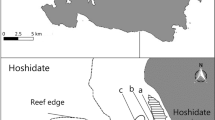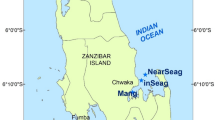Abstract
The structures of fish assemblages in twoThalassia testudinum beds in Guadeloupe, French West Indies, one adjacent to mangroves and the other adjacent to coral reefs, were compared between January 1983 and May 1984. The aim of the study was to compare the influences of mangroves and coral reefs on the utilization of seagrass beds by fishes through examination of species composition, catch rate, size of fishes and temporal changes. The two fish assemblages were similar in terms of the number of species they had in common (nearly 44% of the total number of species collected) and the great abundance of juveniles. They both comprised species that usually inhabit other habitats, i.e., estuaries, open waters or coral reefs. Estuary-associated species (e.g. Gerreidae) were the most abundant species in the seagrass bed near the mangroves, while small pelagic species (e.g. Clupeidae) were the most abundant species in the seagrass bed near the coral reefs. The seagrass bed near the mangroves was preferentially utilized as a nursery area by small juveniles of various species (e.g. Clupeidae, Sparidae, Gerreidae, and at least one coral reef species,Ocyurus chrysurus). The abundance of these species varied frequently, suggesting successive arrivals and departures of juveniles over time. The seagrass bed near the coral reefs was characteristically utilized by fishes that are more able to avoid predation, i.e., fishes that forage over seagrass beds at night and shelter in or near the coral reefs during the day (large juveniles of coral reef species and adults of schooling pelagic species, respectively). The constant migrations of these fishes between the coral reefs and seagrass beds explained the relative stability of the structure of the fish assemblage in the seagrass bed over time. Thus, the two seagrass beds were not equivalent habitats for fishes. The distinct ecological influences of the mangroves (as a nursery for small juveniles) and coral reefs (as a shelter for larger fishes) on the nearby seagrass beds was clearly reflected by the distinct utilizations of these seagrass beds by fishes.
Similar content being viewed by others
Literature cited
Austin, H. M., Austin, S. E. (1971). Juvenile fish in two Puerto-Rican mangroves. Underwat. Naturalist 7: 26–44
Baelde, P. (1986). La faune ichthyologique du lagoon du Grand Cul-de-Sac Marin en Guadeloupe. Ph. D. thesis. Aix-Marseille II University, France
Baelde, P., Louis, M. (1985). Croissance et production des juveniles yellowtail snapper (Ocyurus chrysurus) dans un herbier en Guadeloupe. Proc. Gulf Caribb. Fish. Inst. 38: 485–496
Bell, J. D., Pollard, D. A., Buchmore, J. J., Pease, B. C., Middleton, M. J. (1984). Structure of a fish community in a temperate tidal mangrove creek in Botany Bay, New South Wales. Aust. J. mar. Freshwat. Res. 35: 33–46
Benzecri, J. P., Benzecri, F. (1984). Pratique de l'analyse des données. 1: analyse des correspondences et classification. Dunod, Paris
Brook, I. M. (1977). Trophic relationships in a seagrass community (Thalassia testudinum) in Card Sound, Florida. Fish diets in relation to macrobenthic and cryptic faunal abundance. Trans. Am. Fish. Soc. 106: 219–228
Brothers, E. R., McFarland, W. N. (1981). Correlations between otolith microstructure, growth and life history transitions in newly recruited French grunts (Haemulon flavolineatum Desmaret, Haemulidae). Rapp. P. v. Réun. Cons. perm. int. Explor. Mer 178: 369–374
Carr, W. E., Adams, C. A. (1973). Food habits of juvenile marine fishes occupying seagrass beds in the estuarine zone near Crystal River, Florida. Trans. Am. Fish. Soc. 102: 511–540
Collette, B. B., Talbot, F. H. (1972). Activity patterns of coral reef fishes with emphasis on nocturnal-diurnal changeover. Bull. nat. Hist. Mus. Los Ang. Cty 14: 98–124
Fisher, W. (1978). F.A.O. species identification sheets for fishery purposes. Vols. I–VI. F.A.O., Rome
Galzin, R., Toffart, J. L., Louis, M. Guyard, A. (1982). Contribution à la connaissance de la faune ichthyologique du Grand Cul-de-Sac Marin en Guadeloupe. Cybium 6: 85–99
Gladfelter, W. B., Ogden, J. C., Gladfelter, E. H. (1980). Similarity and diversity among coral reef fish communities: a comparison between tropical western Atlantic (Virgin Islands) and tropical central Pacific (Marshall Islands) patch reefs. Ecology 61: 1156–1168
Harmelin-Vivien, M. L. (1981). Etude des poissons des récifs coralliens de la Guadeloupe. Rapport de la mission “Corantilles I” en Guadeloupe, April (Internal report of Station Marine d'Endoume et Centre d'Océanographie, Marseille)
Heck, K. L., Jr., Orth, R. J. (1980). Seagrass habitats: the roles of habitat complexity, competition and predation in structuring associated fish and motile macroinvertebrate assemblages. In: Kennedy, V. S. (ed.) Estuarine perspectives. Academic Press, New York, p. 449–464
Helfman, G. S. (1986). Fish behaviour by day, night and twilight. In: Pitcher, T. J. (ed.) The behaviour of teleost fishes. Croom Helm, London, p. 366–387
Hobson, E. S. (1973). Diel feeding migration in tropical reef fishes. Helgoländer wiss. Meeresunters. 24: 361–370
Johannes, R. E. (1978). Reproductive strategies of coastal marine fishes in the tropics. Envir. Biol. Fish. 3: 65–84
Kikuchi, T. (1974). Japanese contribution on consumers ecology in eelgrass (Zostera marina L.) beds, with special reference to trophic relationships and resources in inshore fisheries. Aquaculture, Amsterdam 4: 145–160
Kikuchi, T., Pérès, J. M. (1977). Consumer ecology of seagrass beds. In: McRoy, C. P., Helferich, C. (eds.) Seagrass ecosystem: a scientific perspective. Marcel Dekker Inc., New York, p. 147–193
Lance, G., Williams, W. (1966). Computer programs for hierarchical polythetic classification (“similarity analyses”). Comput. J. 9: 60–64
Lance, G., Williams, W. (1967). A general theory of classification sorting strategy. I. Hierarchical systems. Comput. J. 9: 373–380
Louis, M. (1983). Biologie, écologie et dynamique des populations de poissons dans les mangroves de Guadeloupe (Antilles Françaises). Thèse de Doctorat d'Etat. University of Science and Technology, Montpellier II, France
Louis, M., Baelde P. (1987). Fish communities in Guadeloupe mangroves. In: Kullander, S. O., Fernholm, B. (eds.) Proceedings of the Fifth Congress of European Ichthyologists Stockholm. Department of Vertebrate Zoology, Swedish Museum of Natural History, p. 175–180
Louis, M., Lasserre, G. (1982). Etude des peuplements de poissons dans les lagunes des mangroves de Guadeloupe (Antilles Françaises). Oceanol. Acta (Special issue, September) 333–338
Martin, F. D., Cooper, M. (1981). A comparison of fish faunas found in pure stands of two tropical Atlantic seagrasses,Thalassia testudinum andSyringodium filiforme. NE Gulf Sci. 5: 31–37
Munro, J. L. (1983). Caribbean coral reef fishery resources. Stud. Rev. int. Cent. Living aquat. Resour. Mgmt, Manila 7: 1–276
Odum, W. E., Heald, E. J. (1972). Trophic analyses of an estuarine mangrove community. Bull. mar. Sci 22: 671–738
Ogden, J. C. (1976). Some aspects of herbivore-plant relationships on Caribbean reefs and seagrass beds. Aquat. Bot. 2: 103–116
Ogden, J. C. (1980). Faunal relationships in Caribbean seagrass beds. In: Phillips, R. C., McRoy, C. P. (eds.) Handbook of seagrass biology: an ecosystem perspective. Garland STPM Press, New-York and London, p. 173–198
Ogden, J. C., Ehrlich, P. R. (1977). The behavior of heterotypic resting schools of juvenile grunts (Pomadasyidae). Mar. Biol. 42: 273–280
Ogden, J. C., Zieman, J. C. (1977). Ecological aspects of coral reefseagrass bed contacts in the Caribbean. Proc. 3rd int. Symp. coral Reefs 1: 377–382 [Taylor, D. L. (ed.) School of Marine and Atmospheric Sciences, University of Miami]
Olsen, D. A. (1973). The ecology and diversity of fishes in two U.S. Virgin Islands mangrove lagoons. Occ. Pap. Islands Resources Fdn (St Thomas) 27: 1–42
Orth, R. J., Heck, K. L., Jr., Montfrans van, J. (1984). Faunal communities in seagrass beds: a review of the influence of plant structure and prey characteristics on predator-prey relationships. Estuaries 7: 339–350
Pollard, D. A. (1984). A review of ecological studies on seagrass-fish communities, with particular reference to recent studies in Australia. Aquat. Bot. 18: 3–42
Randall, J. E. (1963). An analysis of the fish populations of artificial and natural reefs in the Virgin Islands. Caribb. J. Sci. 3: 31–47
Randall, J. E. (1965). Grazing effects on seagrasses by herbivorous reef fishes in the West Indies. Ecology 46: 255–260
Randall, J. E. (1967). Food habits of reef fishes of the West Indies. Stud. trop. Oceanogr. 5: 665–847
Robblee, M. B., Zieman, J. C. (1984). Diel variation in the fish fauna of a tropical seagrass feeding ground. Bull. mar. Sci. 34: 335–345
Shulman, M. J. (1985). Recruitment of coral reef fishes: effects of distribution of predators and shelter. Ecology 66: 1056–1066
Starck, W. A., II., Davis, W. P. (1966). Night habits of fishes of Alligator Reef, Florida. Ichthyologica 38: 313–356
Stoner, A. W. (1983). Distribution of fishes in seagrass meadows: role of macrophyte biomass and species composition. Fish. Bull. U.S. 81: 837–846
Thayer, G. W., Colby, D. R., Hettler, W. F., Jr. (1987). Utilization of the red mangrove prop root habitat by fish in South Florida. Mar. Ecol. Prog. Ser. 35: 25–38
Weinstein, M. P., Heck, K. L., Jr. (1979). Ichthyofauna of seagrass meadows along the Caribbean coast of Panamá and in the Gulf of Mexico: composition, structure and community ecology. Mar. Biol. 50: 97–107
Author information
Authors and Affiliations
Additional information
Communicated by G. F. Humphrey, Sydney
Rights and permissions
About this article
Cite this article
Baelde, P. Differences in the structures of fish assemblages inThalassia testudinum beds in Guadeloupe, French West Indies, and their ecological significance. Mar. Biol. 105, 163–173 (1990). https://doi.org/10.1007/BF01344282
Accepted:
Issue Date:
DOI: https://doi.org/10.1007/BF01344282




